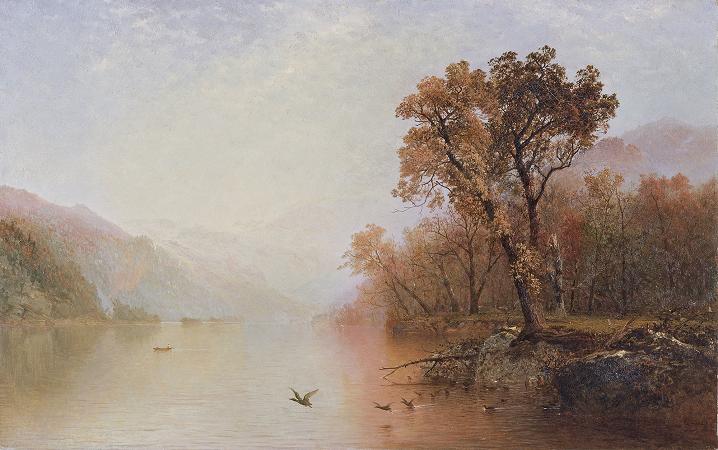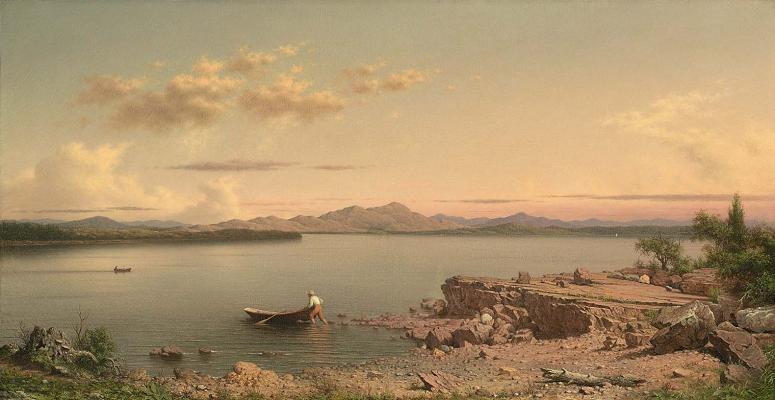Lake George. Lake George, nicknamed the Queen of American Lakes, is a long, narrow oligotrophic lake located at the southeast base of the Adirondack Mountains, in the northeastern portion of the U.S. state of New York. It lies within the upper region of the Great Appalachian Valley and drains all the way northward into Lake Champlain and the St. Lawrence River drainage basin. The lake is situated along the historical natural path between the valleys of the Hudson and St. Lawrence Rivers, and so lies on the direct land route between Albany, New York and Montreal, Quebec, Canada. The lake extends about 32.2 mi on a north-south axis, is quite deep, and varies from one to three miles in width, presenting a significant barrier to east-west travel. Although the year-round population of the Lake George region is relatively small, the summertime population can swell to over 50,000 residents, many in the village of Lake George region at the southern end of the lake. Lake George drains into Lake Champlain to its north through a short stream, the La Chute River, with many falls and rapids, dropping 226 feet in its 3.5-mile course, virtually all of which is within the lands of Ticonderoga, New York and near the site of the Fort Ticonderoga. Ultimately the waters flowing via the 106-mile-long Richelieu River drain into the St. Lawrence River downstream and northeast of Montreal, and then into the North Atlantic Ocean above Nova Scotia. Lake George is located in the eastsouthern Adirondack State Park and is part of the St. Lawrence watershed. Notable landforms include Anthony's Nose, Deer's Leap, Diver's Rock, and Double-Diver's, the Indian Kettles, and Roger's Rock. Some of the surrounding mountains include Black Mountain, Elephant Mountain, Pilot Knob, Prospect Mountain, Shelving Rock, Sleeping Beauty Mountain, Sugarloaf Mountain, and the Tongue Mountain Range. Some of the lake's more famous bays are Basin Bay, Kattskill Bay, Northwest Bay, Oneida Bay, and Silver Bay. The lake is distinguished by The Narrows, an island-filled narrow section that is bordered on the west by the Tongue Mountain Range and the east by Black Mountain. In all, Lake George is home to over 170 islands, 148 of them state-owned. They range from the car-sized Skipper's Jib to the larger Vicar's and Long Islands. Camping permits are attainable for the larger portion of islands. The lake's deepest point is 196 feet, between Dome Island and Buck Mountain in the southern quarter of the lake. The northern end of the lake that is located near Ticonderoga is considered the southern end of the Champlain Valley, which includes Lake Champlain, as well as the cities Plattsburgh, New York and Burlington, Vermont. The Jefferson Project, a collaboration that began in 2014 between IBM, Rensselaer Polytechnic Institute, and the Fund for Lake George, is collecting data from the lake using depth sensors that can monitor currents, pH, salinity, and other data, leading the lake to be called, he smartest lake in the world. There are six known invasive species in Lake George. The Asian clam first found in 2010 is the biggest threat, along with the Eurasian watermilfoil. Other invasive species are the Chinese mystery snail, curly-leaf pondweed, spiny water flea, and zebra mussel. The lake was originally named the Andia-ta-roc-te by local Native Americans. James Fenimore Cooper in his narrative Last of the Mohicans called it the Horican, after a tribe which may have lived there, because he felt the original name was too hard to pronounce. The first European visitor to the area, Samuel de Champlain, noted the lake in his journal on July 3, 1609, but did not name it. In 1646, the French Canadian Jesuit missionary Isaac Jogues, the first European to view the lake, named it Lac du Saint-Sacrement, and its exit stream, La Chute. On August 28, 1755, William Johnson led British colonial forces to occupy the area in the French and Indian War. He renamed the lake as Lake George for King George II. On September 8, 1755 the Battle of Lake George was fought between the forces of Britain and France resulting in a strategic victory for the British and their Iroquois allies. After the battle, Johnson ordered the construction of a military fortification at the southern end of the lake. The fort was named Fort William Henry after the King's grandson Prince William Henry, a younger brother of the later King George III. In September, the French responded by beginning construction of Fort Carillon, later called Fort Ticonderoga, on a point where La Chute enters Lake Champlain. These fortifications controlled the easy water route between Canada and colonial New York.
more...













